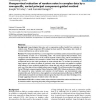BMCBI
2008
13 years 11 months ago
2008
Background: Genome-wide association studies (GWAS) using single nucleotide polymorphism (SNP) markers provide opportunities to detect epistatic SNPs associated with quantitative t...
BMCBI
2008
13 years 11 months ago
2008
Background: Laboratory techniques used to determine haplotypes are often too expensive for large-scale studies and lack of phase information is commonly overcome using likelihood-...
BMCBI
2008
13 years 11 months ago
2008
Background: Large biological data sets, such as expression profiles, benefit from reduction of random noise. Principal component (PC) analysis has been used for this purpose, but ...
BMCBI
2008
13 years 11 months ago
2008
Background: The identification of transcription factor binding sites is difficult since they are only a small number of nucleotides in size, resulting in large numbers of false po...
BMCBI
2008
13 years 11 months ago
2008
Background: Visualising the evolutionary history of a set of sequences is a challenge for molecular phylogenetics. One approach is to use undirected graphs, such as median network...
BMCBI
2008
13 years 11 months ago
2008
Background: Understanding how proteins fold is essential to our quest in discovering how life works at the molecular level. Current computation power enables researchers to produc...
BMCBI
2008
13 years 11 months ago
2008
Background: This paper discusses the problem of automated annotation. It is a continuation of the previous work on the A4-algorithm (Adaptive algorithm of automated annotation) de...
BMCBI
2008
13 years 11 months ago
2008
Background: The zebrafish is a powerful model vertebrate amenable to high throughput in vivo genetic analyses. Examples include reverse genetic screens using morpholino knockdown,...
BMCBI
2008
13 years 11 months ago
2008
BMCBI
2008
13 years 11 months ago
2008
Background: Cell viability is one of the basic properties indicating the physiological state of the cell, thus, it has long been one of the major considerations in biotechnologica...



